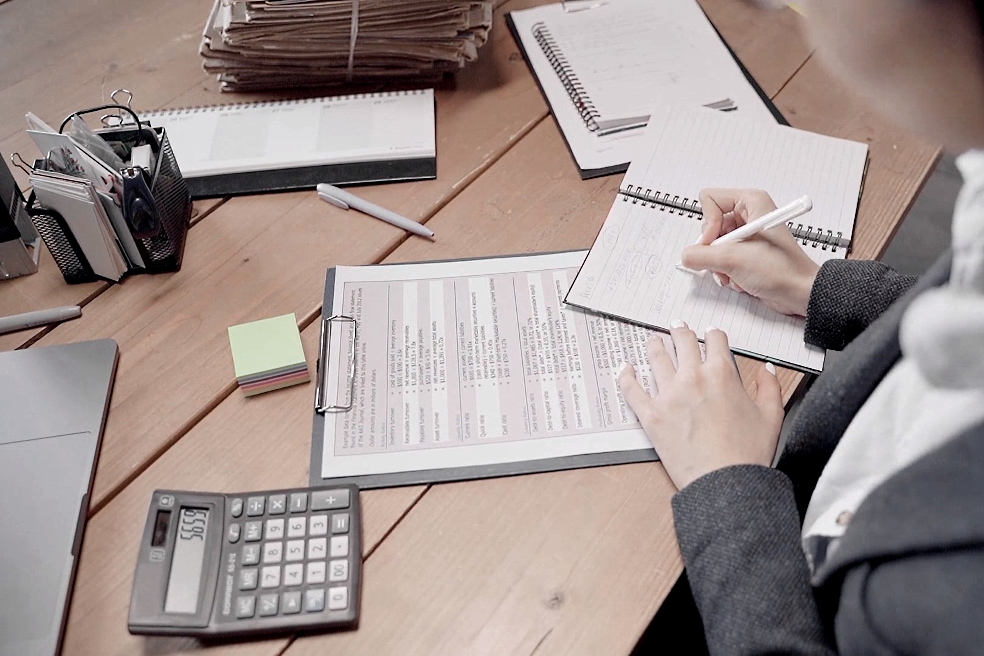Documentary credit (L / C, DLC) for international business financing
Costex Corporation DBA offers:
• Investment financing from $ /€ 5 million or equivalent and more
• Minimizing the contribution of the project promoter
• Investment loan term up to 20 years
• Credit guarantees
In international trade, DLC is becomes an important payment instrument, accounting for more than 15% of international trade.
Costex Corporation DBA offers medium and large companies a wide range of professional services related to servicing documentary letters of credit.
Our specialists are ready to facilitate financial transactions with maximum benefit for clients by providing flexible financial models and schemes.
What is a documentary credit: definition and features
A letter of credit is an official order from one bank to another bank to pay a certain amount to the person (company) specified in the document.In fact, this is the delegation of a future payment, carried out under certain conditions.
To standardize the financial practice of letters of credit, the International Chamber of Commerce in 1933 developed a document called The Uniform Customs and Practice for Documentary Credits (since July 1, 2007, ICC standard No. 600 has been used).
This standard, constantly changing and improving, is valid in more than 175 member countries.
According to international rules, documentary credit means any agreement in which the issuing bank, acting on the order and in accordance with the instructions of the applicant or on its own behalf, undertakes to pay a certain amount to the beneficiary or authorize another bank to make such a payment and pay such costs upon presentation of the package of documents specified in the terms of the letter of credit.
Experts identify the following features of a letter of credit:
• The main obligation to the beneficiary is borne by the issuing bank, which opens the letter of credit.
• The subject of the obligation is the payment by the bank of a certain amount to the beneficiary, and the only evidence of the fulfillment of the conditions of the documentary credit is the official documents listed in its conditions.
• The legal liability of banks is limited. They cannot be held liable for the accuracy, correctness of execution or validity of the documents provided, as well as for any delays in fulfilling the conditions. Banks are also not liable for any losses caused by force majeure.
DLC is an abstract obligation of the bank to provide a certain service (most often just a payment) to the beneficiary, if the latter fulfills the conditions set out in the letter of credit.
It should also be borne in mind that the letter of credit does not replace the main contract between the seller and the buyer, being a separate legally independent transaction. The bank's obligation arising from the letter of credit to pay the invoice or to comply with the instructions arising from the DLC cannot be the subject of any additional demands from the applicant or the beneficiary.
The beneficiary cannot fully rely on the contractual relationship that exists between him and the banks participating in the letter of credit.
Conflicts between the parties arising from improper performance of the main contract, as well as circumstances arising after its signing, do not affect the bank's obligations under the letter of credit.
Characteristics of a documentary credit as a form of payment:
• DLC is a credit form of payment because it is based on a future order issued after delivery / acceptance of goods.
• DLC is viewed as a “conditional” form of payment because the payment is actually made when certain conditions are met.
• DLC in business practice is used to a limited extent, because it is an expensive form of payment, suitable only for large risky transactions.
In general, a documentary letter of credit is the safest form of payment for goods or services, since the bank makes payment only if the specified documents are provided.
The deal is designed in such a way that these documents (which are carefully checked by the bank) confirm the fact that the beneficiary has fulfilled its obligations under the main contract.
Thus, letters of credit are directly related only to the documents listed in the conditions, but not to goods or services that are supplied in accordance with the main contract between the seller (contractor) and the buyer (customer). The bank's only obligation is to verify the submitted documents and make the payment to the beneficiary. The bank is not allowed to investigate any circumstances related to the fulfillment of the contract (for example, whether the goods were shipped on time in sufficient quantity, quality, etc.)
Origin and history of the letter of credit (L / C, DLC)
The prototype of a documentary credit was used in trade long before its modern legal framework was formulated.The history of L / C dates back to 3000 BC, when the merchants of Babylon and Egypt were looking for tools to secure trade transactions.
In the future, letters of credit continue to be used between participants in large transactions and projects for the purpose of security and minimizing costs. Documentary guarantees were used instead of precious metals and other assets for foreign trade.
When trust between countries was broken with the outbreak of the First World War, large banks began to act as guarantors of payments in international trade.
However, the clearer idea of a documentary credit emerged in its current form at the end of the 18th century, continuing to improve as international finance develops to this day.
The International Chamber of Commerce (ICC) was created in 1919 to restore confidence in investment, finance, and trade.
The first rules issued by the organization concerned documentary credits (1933).
Since then, there have been several changes to these rules. The current revision, adopted on July 1, 2007, is the sixth in a row (UCP 600). The purpose of these rules is to introduce uniform standards for banks around the world when making payments using documentary credit.
Their use is voluntary, but not mandatory for financial institutions. These rules have actually shaped the practice of international trade and payments under letters of credit. In addition, their implementation restores trust between participants in trade and financial relations in the world.
In addition to the aforementioned rules and their annexes, there are several foundational documents applicable to international trade and DLC.
One of them is the UN Convention on Guarantees and Standby Letters of Credit, which was signed by several states, but still has limited application.
Another important document is International Standby Practices (ISP98), which refers specifically to one type of letter of credit. It is similar to bank guarantees, but is used in specific cases of non-compliance with the terms of the contract. In addition, when the legislation of many countries does not allow the issuance of guarantees for a specific transaction, which is secured by standby letters of credit.
Main parties of documentary credit
The structure of a letter of credit in international trade may vary depending on the needs of the parties, the level of risk, cross-border transactions, the presence of branches of the issuing bank in other countries and other aspects of a particular transaction.In addition to the issuer, the applicant and the beneficiary, this scheme can include a variety of financial institutions.
The main parties in schemes using a documentary credit are:
• Applicant. This is the person or company that instructs the bank to make the payment. An applicant is usually a purchaser of goods or services who must pay for them to a supplier or manufacturer (contractor).
• The issuing bank that opens the letter of credit and undertakes to pay the beneficiary upon the occurrence of certain conditions.
• Beneficiary. This is a company or person that acquires property rights under a letter of credit, that is, the recipient of payment for goods or services.
Often, the issuing bank does not have any branches in the country of registration of the beneficiary.
In such situations, as well as in order to improve the reliability of the transaction, participants can attract additional banks, which are listed below:
• Advising bank. This financial institution notifies the beneficiary of the opening of the DLC. The advising bank does not assume any financial obligations and, in fact, does not participate in the payment.
• Executing bank. This party to the transaction makes payments to the beneficiary of the letter of credit, but does not undertake any obligations under it. He pays as a third party, the beneficiary cannot demand anything from this party.
• Confirming bank. This party takes a formal obligation to the beneficiary to pay. In this case, the beneficiary will have two banks at his disposal. This is the safest, but also the most expensive scheme.
• Reimbursing bank. This financial institution must provide funds under the letter of credit, effectively acting as an intermediary in the transaction.

The key participant in all transactions is the applicant, who is the importer of goods (services) in the context of international trade activities.
The applicant issues an order to open a letter of credit and provides funds to secure it.
Documentary credit in international trade
Documentary credit is currently the safest form of payment in international trade, as reputable banks are closely involved in this mechanism.In 2017, total financing for trade transactions exceeded € 4.5 trillion, with a significant portion of which was funded through DLCs or standby letters of credit. Only less than half of transactions at the international level were carried out through traditional bank guarantees and documentary collection.
As for statistics, transactions with letters of credit have the lowest share of non-payments (this indicator before the pandemic ranged from 0.03 to 0.08%). These figures make documentary credit and standby the most reliable trade finance instruments.
The legal framework for letters of credit is currently sufficient for making this type of payments in most countries.
Difficulties are mainly related to differences in internal procedures and regulations of banks and financial institutions in different parts of the world and a lack of understanding of this practice among local business communities.
Despite the important place that DLCs occupy in the financing of international trade, there has been a recent trend towards a decrease in their share and an increase in other financial instruments. This can be explained by the tightening of requirements for letters of credit, as well as new risks and increased protectionism in international trade.
In the medium term, a slight decrease in the number of payments using documentary credits is expected due to the overly complex requirements for assessing credit risk and the large number of documents to be presented. The development of IT and the rapid digitalization of banks also contribute to minimizing costs and time for carrying out mutual settlements with other financial instruments.
Types of documentary credit: classification
In the practice of international trade, dozens of types of letters of credit have been developed.A detailed description of all of them is beyond the scope of this article. Letters of credit can be classified depending on the collateral, the obligations of the issuing bank, the role of the intermediary bank and other criteria.
Types of L/C depending on the bank's right to cancel obligations:
• Revocable letter of credit. This document can be canceled by the bank at any time before the payment is due. This type of letter of credit has not received wide practical application, because it does not create security for the beneficiary.
• Irrevocable letter of credit. The bank cannot revoke this letter of credit after notifying the beneficiary, but the document can be revoked or changed with the consent of the latter.
Types of letter of credit depending on the bank's obligations:
• L / C at sight. This document provides for the payment of the beneficiary immediately after the fulfillment of the previously agreed conditions. Most often used.
• L / C with deferred payments. Paid after a certain time after the submission of documents. It serves as a form of loan to the payer from the beneficiary as the beneficiary considers making the payment later.
There are letters of credit that are not essentially forms of payment and are mainly used in Anglo-American financial systems:
• Letter of credit for accepting a bill of exchange. The bank must accept a bill of exchange issued by the beneficiary (bill of exchange in which the issuer and the borrower are the same person and the payer is the bank).
• Letter of credit for negotiations. The bank is obliged to purchase bills of exchange or other documents issued by the beneficiary (redemption of bills of exchange).
Types of documentary credits depending on coverage:
• Letter of credit secured. The buyer (importer) transfers the full amount of the letter of credit in advance to a special account with the issuing bank. The supplier of the goods in this case receives a guarantee equivalent to the advance payment for the goods.
• Letter of credit unsecured. This option allows the importer to make a payment without diverting working capital. The use of financial instruments without collateral is not possible for all companies and depends on the size of a particular importer and his relationship with the bank.
• Letter of credit unsecured with deferred payment. This type of documentary credit is used if the seller is willing to provide a trade credit to the importer (buyer) and if it is possible to open an unsecured letter of credit.
DLC can be "divisible" or "indivisible" (depending on the possibility of payment in full or in parts), transferable or non-transferable (depending on the use by other beneficiaries).
Advantages and disadvantages of the DLC for project participants
The feasibility of making settlements on a transaction using a letter of credit can be assessed in terms of the advantages and disadvantages of this instrument for each participant.Table: Advantages and disadvantages of the DLC.
| Participants | Advantages | Disadvantages |
| Importer |
|
|
| Exporter |
|
|
A letter of credit as a form of payment is especially beneficial to its beneficiary (usually an exporter of goods or services).
The importer can also benefit from a documentary credit.
The advantages of this form of payment are the guarantee of compliance with the terms of the contract by the exporter, as well as a direct impact on the date of shipment and the selection of documents confirming the fulfillment of the contract.

From the point of view of the beneficiary, the complexity and duration of the arrangement of the transaction can be seen as a deterrent. A letter of credit involves a lengthy verification process during which its terms and conditions are verified. Preparing documents for submission to the bank requires a lot of work. From the point of view of the applicant, the disadvantage of the letter of credit is the need to freeze a certain part of the working capital before the delivery of the goods.
Despite the disadvantages, this form of payment should be used when concluding deals with a little-known partner and other risky contracts.
A documentary credit guarantees the security of both parties to the contract.
Practical use of a letter of credit: legal aspects
A documentary credit refers to a transaction through which a bank commits itself to a beneficiary.The latter must be notified in a timely manner. The bank's obligation occurs when standard requirements are met, which usually means the provision of certain documents to the bank (hence the name "documentary").
Stages of using DLC for export-import operations:
1. The company opens a letter of credit in its bank in favor of the seller or exporter. The requirement for making a payment is the submission of a package of documents confirming the seller's fulfillment of obligations under the main contract. The importer's bank notifies the seller's bank about the opening of the letter of credit.
2. The seller delivers goods in accordance with the contract.
3. The bank receives a package of documents that confirm the fulfillment of the terms of delivery, and checks them.
4. The importer's bank transfers to the seller's bank the amount indicated in the letter of credit.
The letter of credit is secured in a manner agreed with the bank. This can be, for example, a bank guarantee, surety, blocking of funds in an account with another bank, or a loan to secure an order accepted by the issuing bank.
In some cases, participants in foreign trade operations use pre-export financing schemes. The exporting company, or the beneficiary of the letter of credit, receives a loan from its bank to manufacture or supply the goods that are to be exported. In this case, the potential proceeds from the sale of this consignment of goods can serve as security for the loan.
A transferable letter of credit can be used by exporting companies when it is necessary to settle accounts with suppliers without diverting working capital. Also, an obligation under a letter of credit can be divisible, that is, the bank makes payment in several installments when a part of the documents is provided or the beneficiary submits a request for partial payment.
As we can see, in the case of the import of goods or services, a documentary credit can serve as an extremely flexible instrument for settlements between participants.
In the case of export, the letter of credit acts as a guarantee of payment for goods / services by a foreign partner.
The terms of the letter of credit allow companies to choose any payment currency, depending on the needs of a particular business. The contract indicates the date of opening the letter of credit, the validity period, a list of documents for receiving funds, the deadline for their submission, etc.
Requirements for registration and submission of documents
A documentary credit is a separate agreement that should be considered independently of the main contract between the applicant and the beneficiary.In practice, this is a digital message that the issuer sends to the beneficiary's bank. A letter of credit is considered open from the moment a standardized digital message about its opening is sent.
The application for opening a letter of credit may differ, but in all cases it must contain the following mandatory details:
• Type of letter of credit.
• Confirmation with the details of the confirming bank.
• Date of application for opening letter of credit.
• Validity period and place of payment.
• Name of the beneficiary's company, its location.
• Name of the beneficiary bank and executing bank.
• Description of goods (services) under the main contract.
• Terms of delivery according to Incoterms.
• List of documents for payment under the letter of credit.
• Method of execution of the letter of credit.
• Terms of payment of bank fees.
Key roles in the functioning of this financial instrument are played by a bill of lading, a freight insurance policy or an invoice.
The bank must carefully check the documents, whether they meet the requirements specified in the letter of credit.
There can be a difference between the documentary requirements. All documents are considered together, with the invoice considered the most important. Verification of these documents is usually carried out by the bank within 7 working days, since the specified period is established by international financial practice.
In principle, documents should be reviewed within a reasonable time frame.
This is especially important in cases where the goods have been sent, but it is possible to stop the delivery.
After evaluating the documents, the bank must decide whether to pay the money or not.
The lack of documentary credit can be seen at this stage, since seemingly insignificant clauses in the documents can greatly affect the functioning of this financial instrument and its consequences for the parties.
The bank checks the documents according to the principle of formalism, that is, the payment to the beneficiary may be refused in case of the slightest deviation from the requirements of the letter of credit. Although in the world financial practice there are numerous court decisions that allow the beneficiary to receive their money in doubtful cases, the general approach of banks is formal.
It should also be mentioned that in the case of a so-called irrevocable letter of credit, the bank is not obliged to comply with the applicant's orders related to any change in its obligations to the beneficiary.
Obligations and responsibilities of the participating parties
A letter of credit is a formal transaction that requires a written form.This is an abstract deal.
A documentary credit refers to bilateral agreements, since it creates obligations only for the bank and the ordering party.

Table: Obligations of the applicant and the bank under the L/C
| Obligations of the applicant | Obligations of the bank |
| The applicant is obliged to provide coverage under the letter of credit, if such is provided for by the terms of cooperation | When and if the beneficiary submits the documents, the bank must quickly check whether they comply with the terms of the letter of credit. |
| The applicant is obliged to pay expenses and interest on time, plus reimburse the bank for losses. | The bank is obliged to make the payment in full within the agreed time frame if the conditions stipulated by the agreement are met. |
| The applicant provides the bank with the necessary documents to open a letter of credit and ensure its functioning. | The bank is obliged to inform the applicant about the circumstances important for the execution of the letter of credit. |
| The bank is obliged to provide the invoice to the applicant and submit the required documents under the letter of credit. |
An important responsibility of the bank when working with DLC is to check documents and make a payment.
This aspect will require special attention at the preparatory stage.
The abstract nature of the letter of credit is the result of justified efforts by banks that are members of the International Chamber of Commerce to free financial institutions from the risk of disrupting transactions between parties, on the conclusion and execution of which they have virtually no influence.
The system of legal relations under a DLC includes the following:
• Delegation of payment based on the relationship that develops between the issuing bank of the letter of credit and the paying bank. The agreement on opening a letter of credit is concluded between the applicant and the issuing bank.
• Relationship in the context of collateral between the issuing bank and the paying bank. Within the framework of these legal relations, the issuer provides the paying bank with money to make the payment. The coverage ratio is formed between correspondent accounts (nostro and vostro).
• Currency relations between the issuing bank and the beneficiary. Determination of this ratio is the basis for the functioning of the letter of credit. In accordance with this legal relationship, the issuing bank guarantees that the required amount will be paid by the payer, being a promise of third party actions.
In fact, there is no legal relationship between the paying bank and the beneficiary under the documentary credit.
Some of the limitations of banks' liability under a letter of credit are listed below:
• The bank is not responsible for errors in the transmission of messages.
• The bank is not responsible for non-fulfillment of obligations under foreign exchange legal relations between the applicant and the beneficiary under the main contract (for example, an international trade agreement).
• The issuing bank is not responsible for the actions or inaction of other banks.
• If the applicant has appointed another bank, but the issuing bank has deviated from such an order, the latter is liable. The same applies when the payment is not made between different banks.
Closing a letter of credit is governed by clear rules
This is possible in such cases as the expiration of the letter of credit, refusal of the beneficiary to use the letter of credit before its expiration date, revocation of the document, and so on.The nominated bank must immediately notify the issuing bank of the closure of the DLC. Upon closing the secured executing letter of credit, the bank transfers the unused cover to the issuing company and the issuer returns the money to the client.
If you are interested in DLC advice or other documentary credit services, please contact the LBFL finance team.
Our company offers professional financial services for large businesses in Europe, USA, Latin America, East Asia, the Middle East and other regions of the world.
We are ready to provide financial resources for the development of your business and accompany your investment projects from the planning stage to launch.




















